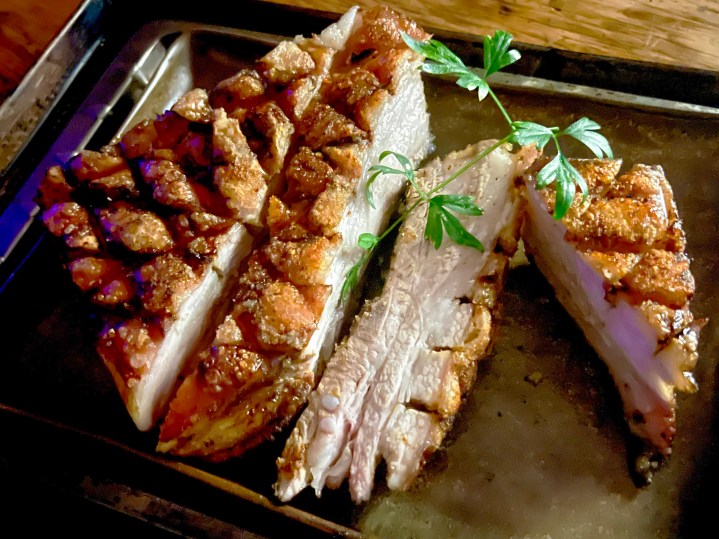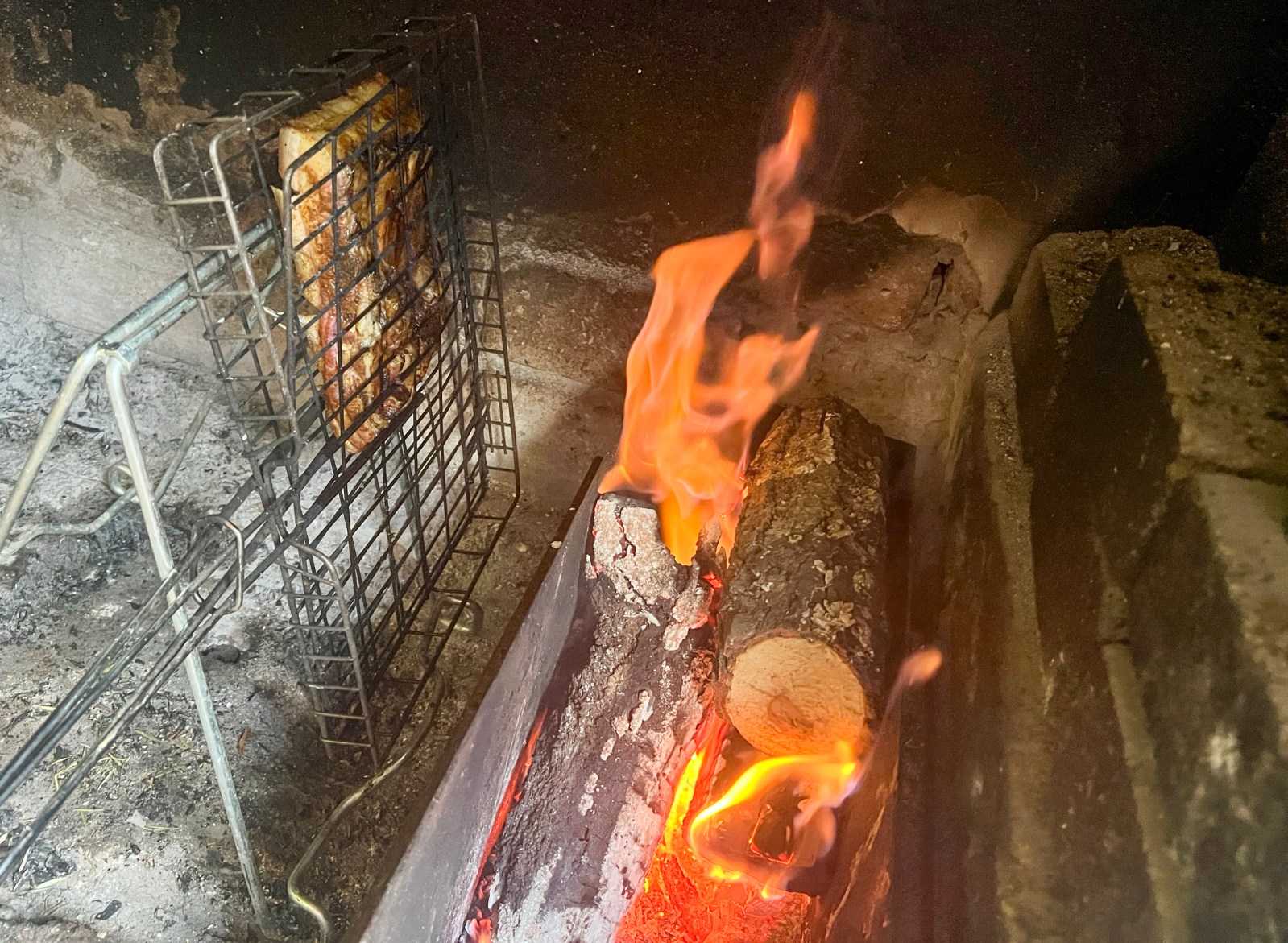CRUNCH TIME
A Crackling Good Quest: The ‘Can you braai pork belly?’ edition

Well? Can you braai a whole pork belly? Yes, you can. You’d think it would turn out tough and inedible, but the trick is to treat it exactly the way we braai lamb flanks in the Karoo: slowly, and side-on.
Welcome to the ninth edition of our Crackling Good Quest in search of the perfect pork crackling. It’s been running for almost as long as TGIFood, and our readers have lapped it up every time. But: on the braai? Really?
Well, yes, as it happens. It’s all about equipment and time. A braai stand is an essential piece of equipment for the Karoo braaier. I don’t mean those three-legged potjie stands. I mean the ones that are designed for you to cook your lamb or mutton flank side-on to the heat source.
This enables you to “stand” your meat at a slight angle so that the heat source rises from below rather than have the meat facing the heat. The cooking is very slow and gentle. It looks like this, but bear in mind that a fresh batch of wood had just been added:

Pork belly cooking side-on to the heat. In this instance, the heat source is logs burning in an ember maker. The flames should not be at full force as shown here for the entire cooking duration. (Photo: Tony Jackman)
Ember maker? That’s the iron implement that you make your fire in in a standard South African braai.
The meat in the photo above is not lamb flank, however, but a chunky piece of pork belly. A friend in my Karoo town did this over the New Year weekend, and I love learning a new trick so I paid close attention.
Being a thick hunk of meat with bones, it needs a lot of time. My friend, whose family farms pigs (so this was meat of high quality), cooks his for three hours in this way, before scooping in plenty of hot coals and placing the belly skin-side down so that the crackling can turn astoundingly crunchy and delectable. It was the perfect crunch you always hope for in pork crackling — and on the braai, would you believe?
A few days later, I cooked a slab of pork belly in the same way, using an ember maker to provide the heat. This meant that logs were burning for a full three hours, which is quite heavy on the wood stocks. The alternative is to have a layer of coals on the braai floor in front of the braai stand, and to top them up as needed. Either way, you need to burn wood constantly.
Whether to baste or not is your choice. There’s nothing wrong with the flavour of pork meat that has only been seasoned with salt and pepper (which is how my friend chose to do it), but it takes well to a baste that includes honey, or another sweet condiment such as sweet soy sauce, and some deft spicing.
Another advantage of braaing pork side-on in this way is that a good deal of the fat drips away over time.
If you don’t own a braai stand of this kind, you could lean a hinged grid against a wall of your braai.
You may like to read our previous A Crackling Good Quest pieces: Make it snappy here, Just add lemon here, Soy, orange and rosemary here, Air fryer pork belly and crackling (in an Instant Pot) here, Pork belly in nagmaalwyn here, My son-in-law Neal Derman’s crackling here and Slow crackling here. There’s also this air fryer edition.
(Serves 4 to 6)
Ingredients
1 slab of pork belly, skin on
Salt and black pepper
Baste:
⅓ cup raw honey
Juice of 1 lemon
1 Tbsp smooth mustard
½ tsp each of ground cumin and coriander
Method
Mix the baste ingredients for later use.
Using a very sharp knife, score the hard skin of the belly in strips about 1.5 cm apart. But be careful not to cut into the soft fat below.
Rub salt into the skin and into the cracks in between.
Prepare plenty of hot coals, ideally in an ember maker.
Place the salted pork belly in a clean hinged grid, and position it fairly near the heat source with the bone side of the belly facing the heat. Don’t baste it at this point; you want to get the meat cooking for a while first.
For three hours, keep the heat going at a rate (and distance from the heat) that will have the belly cooking very slowly but steadily. If, for instance, it starts to brown quite soon, it might need to be moved a little further away. The point is to get the meat beautifully tender and cooked all the way through, without the outside becoming dry and overcooked.
After an hour, start to baste on the side that’s facing the heat, every now and then.
Also after an hour, the belly can be turned around for the fat side to start cooking. But for most of the cooking, the bone side should get most of the heat’s attention.
Once three hours have passed, gather hot coals in the centre of the braai and put the grid above it with the skin side facing the coals.
Over 15 to 20 minutes or so, the skin should have turned wonderfully crunchy. Let the meat rest off the heat for 15 minutes before serving.
For a side dish, coleslaw would be perfect. Here are two of my coleslaw recipes: coleslaw revisited, and Karoo koleslaw. DM
Tony Jackman is Galliova Food Writer 2023, jointly with TGIFood columnist Anna Trapido. Order his book, foodSTUFF, here
Follow Tony Jackman on Instagram @tony_jackman_cooks.




That is not a braai stand, it is a clothes drying rack. Hope the person who does the laundry in the house is not a reader…
I, too, used to battle cutting through the skin to just the right depth. Then I came across a recipe cutting from the meat side. I believe this is the Mexican way. Obviously, this is belly sans bone. Cut 2″ grid sections all the way to just below the skin. Cook slowly for around 3 hours – I use a kettle – at around 105. This saves on wood & coals. Then I cheat. Toss it in the airfryer, skin up, for about 5 minutes at 230. The whole eating experience is literally gobsmacking. The crackling is like a crisp wafer!
When you say you use a kettle, could you explain please? Not a tea kettle, obviously…. 🙂
Kettle as in Weber or equivalent?
This seems like a big faff, requiring a huge amount of wasteful wood burning and attention to the fire over several hours. Americans have perfected the art of “low and slow” bbq with tough cuts of meat like pork belly, ribs, brisket etc. They use bbqs like off-set smokers, ceramic Kamado bbqs, Weber Smoky Joes or even at a pinch you can use an ordinary Weber kettle on indirect heat and controlling the temp with the vents. I have a Kamado Joe, which uses tiny amounts of charcoal to cook at a low temp over several hours. You can crisp the crackling over direct heat at the end.